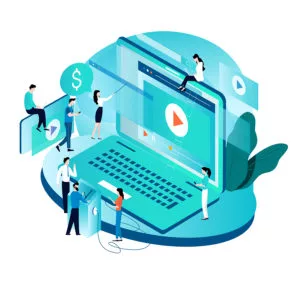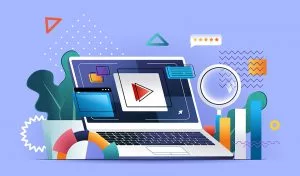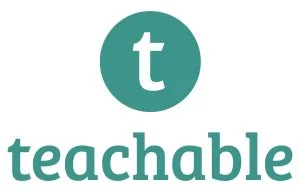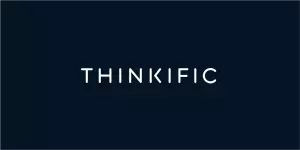Thinkific and Teachable are online course platforms that facilitate the creation and publication of course content digitally.
The most prominent of these content media is the video format that can also offer interactive engagement between instructor and learner through live streaming.

Video files by design are usually large and require equally large storage capacity and the right video asset management to optimize raw footage to high-quality videos for streaming.
Online course platforms do not have such capacity and tools and only provide basic video production capability that may not handle high-quality or lengthy online video courses.
Integrating a specialized video management system to handle content on Teachable and Thinkific platforms elevates standards and enhances user experience.
The two online course platforms need video management systems to optimize their service and attract more content viewership as demand for online video content increases.
Today’s learner has more expectations when seeking online services, and content quality is a primary consideration. Basic quality videos that cannot stream smoothly across devices lower the platforms’ attractiveness to both content creators and viewers, leading to lost subscriptions.
Both Teachable and Thinkific require a video management system to enhance user experience and retain subscribers.
Online Video Courses: How to make the most out of your online courses

Conventionally and previously, learners in any discipline received in-person instruction in a physical class set up with a tutor. However, with modern technology, especially online video and high-speed connectivity gaining ground, recorded and even interactive video tutorials have sprung up.
Online course platform has come as a relief to many working persons seeking to improve their skills or earn an additional college degree through a flexible program. Learning online allows the student to study at their convenience wherever they may be and in whatever form that works for them while balancing family and work obligations.
However, online video courses can pose challenges to a learner without the requisite skills to interact on digital platforms.
1. A student must practice a high level of self-discipline to stay focused and follow the program diligently as the online courses shift accountability and supervision to the learner.
2. Despite the apparent flexibility, you must plan your schedule prudently to balance all obligations through effective time management and check in frequently to ensure you stay on course.
3. Set up a regular study schedule with reminders of major assignments and create a conducive study space with a reliable internet connection, course software, and other materials.
4. Learning through an online course can present serious distractions either from the immediate surroundings or the temptation to click on social media buttons. Identify the likely distractions you may encounter and move to eliminate these with an alternative arrangement while figuring out what study system works best for you.
5. In most cases, online programs have interactive forums that encourage group discussions and in which you can participate to have a better learning experience.
6. Build a strong network with fellow students over this forum to foster collaboration over assignments and seek guidance from the instructors through emails.
What is a video management system?

A video management system (VMS) combines video software and server hardware to facilitate real-time monitoring of events from surveillance devices.
The hardware part includes CCTV cameras, monitor screens, encoders if you use analog cameras and servers for storage and video processing. When selecting hardware, match your server choice with the expected load capacity providing an ample amount of storage space for review needs.
A perfect ensemble should comprise a full-depth rack mount and connectivity options through monitor outputs and network ports for efficient performance.
Selecting a video management software is delicate and must consider such factors as architecture, efficiency, camera integration, licensing, and the software management agreement (SMA).
Processing efficiency should be at the heart of your video management applications strategy to ensure you select servers that can handle multi-camera software with no glitches.
You should opt for constant communication video management systems with a server-client built to achieve simple configuration, scalability, and flexibility, including camera integration.
Purchase your software from a reputable vendor that can provide and install licenses alongside an affordable Software Maintenance Agreement (SMA) to guarantee reliable tech support and regular upgrades whenever new versions emerge.
In the absence of support from a technical partner, a simple to install and operate license helps optimize your engineering resource in the overall video asset management strategy.
Whereas superior VM systems have deep and full integration, budget versions will at least allow an elementary level of constant two-way communication between devices such as intercoms, alarm panels, fire systems, and access control.
An intuitive menu and simple user configuration that offers built-in help files ensure enhanced performance on reduced engineering resources.
Modern video management systems now incorporate connectivity across platforms such as mobile devices and web interfaces for better remote access and control.
Why is video management software important for video courses using online courses platforms such as Teachable and Thinkific?

A video management software is the ultimate tool for handling high quality and quantity public-facing video content such as tutorials on Teachable and Thinkific platforms.
Whereas regular CMS platforms can still handle video content, using a specialized system has more benefits for video content management and delivery.
By default, video files are usually large compared to other media types for images, and the size increases exponentially with quality and length.
Video CMSs are scalable with capacity for dedicated storage and the capability to handle content uploads and delivery efficiently.
Many people across the world now interact on their smartphones and find it convenient to access their online video courses on these mobile platforms wherever they may be and at whatever time. And this is where a video management system comes in handy as the specialized CMS automatically converts video files to fit multiple device formats through transcoding.
Transcoding helps deliver optimized disruption-free streaming across devices and is adaptive to the destination internet connection speeds to avoid buffering time lags for a better user experience.
Video CMSs also offer live broadcast options suitable for webinars and real-time interaction between instructors and their learners while saving the video at the same time.
Online instructors would like to get insights into how their videos perform on the online course platform for future improvement. Specialized video content management software provides inbuilt analytics for tracking video metrics to determine engagement performance.

Besides insightful analytics, video CMSs also enhance content search experience with superior indexing to the extent of selecting specific video parts through speech recognition and target words.
You will also enjoy enhanced privacy, security, and control over your public-facing videos with better encryption and authentication processes for access.
11 Benefits of video management system for Online Courses
Teachable and Thinkific provide a unique platform with a basic player for online video courses, especially through uploaded video content.
However, the quality of the posted online videos depends entirely on the content creator’s prowess and tools, and this is where using video management systems enhances the content production process.
Video content management systems assist publishers in product building and production and in video organization, storage, online distribution, and ultimately the eventual monetization.
Video CMSs have come as a boon to the thriving but developing online video business and enhance the user experience on platforms such as Teachable and Thinkific.
- Allowance for a dedicated large video files storage is one benefit you will not find on conventional content management systems operated by intellectual platforms.
- Dedicated storage provides capacity for boosted streaming across devices with near-zero disruptions through adaptive video formats achieved by transcoding.
- Automatic adjustment of video quality to match destination internet speeds while minimizing buffering that would otherwise affect the smooth delivery of an online course to learners.
- Video CMSs provide publishers with unrivaled privacy, control, and security of their content with superior encryption and authentication process besides the option to front content with a paywall.
- An advanced content organization that allows built-in intuitive search functions that provide a seamless and pleasant user experience.
- The inclusion of dynamic playlists, galleries, metadata-assisted indexing, and speech recognition raises online videos to another level on any online course platform.
- Video analytics help the publisher to collect valuable real-time insights on the performance of their content.
- Besides recorded content, a publisher can conduct live streaming for real-time interaction with learners.
- Publishers need video management software that incorporates video encoding and transcoding to compress and optimize raw footage for playback on different devices.
- A hassle-free distribution process that helps publishers expand their business.
- Combine the power of video management software and online course platforms.
Why do you need both of them and can’t replace one with the other
Online course platforms are a virtual alternative to on-premise in-person learning setup. The platforms operate on learning management systems (LMS) that provide a medium for instructors to create teaching content and upload for digital transmission to learners.
The instructor creates and uploads the course content like video, audio, image, text, or PDF files and grants controlled access to target students through a paywall.
An online course platform facilitates intellectual entrepreneurs to create, market, and sell online courses with ease.
A video content management software is an application that runs storage, management, organization, and publication of optimized online video content.
Video CMS can assist content creators in developing scalable video asset management to handle customer-facing videos such as online courses.
Video publishers seeking to offer premium content need a video CMS to handle the large file storage capacity required for high-quality videos.
The CMSs protect and optimize your content on the online course platform guaranteeing your income through paywall-controlled access and an enhanced user experience for the learners.
Combining the online course platforms and video content management software unleashes limitless opportunities for intellectual content entrepreneurs.
Video management software is the ultimate game-changer for content creators and complements the functions of online course platforms to create a vibrant and lucrative video ecosystem.
Bringing video-specific analytics to the online platform’s basic structures helps the course owners collect valuable insights for future improvements while assessing performance.
The online course platform provides a tailor-made medium to develop and market your content, whereas the video management software optimizes your content and engagement on the platform – you need both!
What is video management software?
Video management software is an application that runs video surveillance cameras or is used in video content management systems for the production of online videos.
When running a video management system for security surveillance, the software integrates cameras, recording systems, encoders, analytics, storage infrastructure, and gateway systems to provide a unified interface for video monitoring.
The VMS in security applications is integral to an organization’s security strategy and execution, always collecting data, recording, storing, and allowing later retrieval for analysis.
The application of the video management software has gone beyond surveillance to use by large stores in tracking customer activity and behavior.
Content video management software is especially useful for content creators developing videos for online viewing.
Online course platforms are the one sector that is increasingly adopting VMS to streamline production, distribution, and the monitoring of their content for quality.
The video management software helps to organize and manage all media content, including videos, graphic images, texts, and PDF documents efficiently on any online platform.
A video management software application on a specialized CMS can also handle the hosting and streaming of high-quality video files smoothly and securely.
Cincopa for powering your Thinkfic and Teachable content
Thinkific and Teachable are popular among video course creators owing to their easy-to-use interface.
Both the platforms offer video management tools to help tutors all the way from creating a video-based course curriculum to managing the audience post-launch.
A big drawback you face with these platforms when your courses become popular and your audience size is above average is that they do not offer content customization and video enhancement options.
When you are upping your game, the last thing you would want is to manage the show with basic features that were ok only up to a particular point.
This is where we at Cincopa can help you. With our enterprise video content management, you get multi-layered video security, which is essential for monetizing online courses.
Combined with advanced video analytics from Cincopa, you stay in full control of everything and make strong analytics-based decisions to take your course to the next level.









